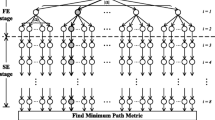Abstract
A new low complexity lattice reduction algorithm was proposed, namely, the sorted integer Gauss transformation (SIGT). The SIGT algorithm can be interpreted as minimizing the longest basis vector first and assure that there was no integer projection between any two basis vectors. By applying simulation over Rayleigh fading channels, it was demonstrated that the proposed SIGT algorithm can have almost the same bit error rate (BER) performance as the LLL algorithm, while the SIGT algorithm requires only about half iteration as the LLL algorithm and the running time of each iteration for both algorithms were similar to each other. It is concluded that the SIGT algorithm can achieve almost the bit error rate (BER) performance, while the SIGT requires fewer iterations than the LLL.






Similar content being viewed by others
References
Niroomand, M., Derakhtian, M.: A low complexity diversity achieving decoder based on a two-stage lattice reduction in frequency-selective mimo channels. IEEE Trans. Wireless Commun. PP(99), 1–1 (2017)
Huazhang, L.: A novel generalized lll algorithm in lattice reduction for mimo system. Telecommun. Radio Eng. 76(6), 491–509 (2017)
Park, M.W., Lee, S.W., Kim, T.H.: A low-complexity processor for joint qr decomposition and lattice reduction for mimo systems. J. Inst. Electron. Inf. Eng. 52(8), 40–48 (2015)
Li, J., Lv, H.: A modified effective lll reduction for lattice decoding in mimo system. J. Comput. Inf. Syst. 11(12), 4321–4331 (2015)
Stern, S., Fischer, R.F.H.: Joint algebraic coded modulation and lattice-reduction-aided preequalisation. Electron. Lett. 52(7), 523–525 (2016)
Huang, Q., Burr, A.: Low complexity coefficient selection algorithms for compute-and-forward. IEEE Access PP(99), 1–1 (2017)
Liu, J., Xing, S., Shen, L.: Lattice-reduction-aided breadth-first tree searching algorithm for mimo detection. IEEE Commun. Lett. PP(99), 1–1 (2017)
Wang, W., Hu, M., Li, Y., Zhang, H., Li, Z.: Computationally efficient fixed complexity lll algorithm for lattice-reduction-aided multiple-input–multiple-output precoding. IET Commun. 10(17), 2328–2335 (2016)
Dias, S.M., Vieira, N.J.: Concept lattices reduction: definition, analysis and classification. Expert Syst. Appl. 42(20), 7084–7097 (2015)
Haroun, A., Nour, C.A., Arzel, M., Jego, C.: Low-complexity soft detection of qam demapper for a mimo system. IEEE Commun. Lett. 20(4), 732–735 (2016)
Wang, Y., Zhao, D., Liao, X.: Low-complexity group precoding in multi-beam satellite systems. Harbin Gongye Daxue Xuebao/journal of Harbin Institute of Technology 47(3), 77–82 (2015)
Ramirez-Gutierrez, R., Zhang, L., Elmirghani, J.: Antenna beam pattern modulation with lattice-reduction-aided detection. IEEE Trans. Veh. Technol. 65(4), 2007–2015 (2016)
Song, Y., Liu, C., Lu, F.: Lattice reduction-ordered successive interference cancellation detection algorithm for multiple-input–multiple-output system. Signal Processing Iet 9(7), 553–561 (2015)
Haque, M.M., Pieprzyk, J.: Analysing recursive preprocessing of bkz lattice reduction algorithm. IET Inf. Secur. 11(2), 114–120 (2017)
Bai, L., Li, T., Zhao, L., Choi, J.: Lattice reduction-based iterative receivers: using partial bit-wise mmse filter with randomised sampling and map-aided integer perturbation. IET Commun. 10(11), 1394–1400 (2016)
Kim, H., Kim, M., Lee, H., Kim, J.: Lattice-reduction-aided partial marginalization for soft output mimo detector with fixed and reduced complexity. IEEE Commun. Lett. 20(7), 1297–1300 (2016)
Fang, S., Wu, J., Lu, C., Yue, Z.D.: Simplified qr-decomposition based and lattice reduction-assisted multi-user multiple-input–multiple-output precoding scheme. IET Commun. 10(5), 586–593 (2016)
Ma, Y., Yamani, A., Yi, N., Tafazolli, R.: Low-complexity mu-mimo nonlinear precoding using degree-2 sparse vector perturbation. IEEE J. Sel. Areas Commun. 34(3), 497–509 (2016)
Li, J.: A novel fix-effective-lll algorithm using fast-givens rotations for mimo system. J. Inf. Comput. Sci. 12(12), 4603–4613 (2015)
Shrestha, K., Mompean, G., Calzavarini, E.: Finite-volume versus streaming-based lattice boltzmann algorithm for fluid-dynamics simulations: a one-to-one accuracy and performance study. Phys. Rev. E 93(2–1), 023306 (2016)
Acknowledgements
The authors would like to express appreciation to the anonymous reviewers for their helpful comments. This paper was supported in part by Capability Improvement Project of Zhangjiang Administrative Committee of Shanghai Municipality (No. 2016-14), and in part by Science and Technology Commission of Shanghai Municipality (No. 16511104204).
Author information
Authors and Affiliations
Corresponding author
Rights and permissions
About this article
Cite this article
Tang, J., Bian, X. A novel low complexity lattice reduction algorithm for MIMO detection. Cluster Comput 22 (Suppl 6), 13995–14001 (2019). https://doi.org/10.1007/s10586-018-2167-2
Received:
Revised:
Accepted:
Published:
Issue Date:
DOI: https://doi.org/10.1007/s10586-018-2167-2




